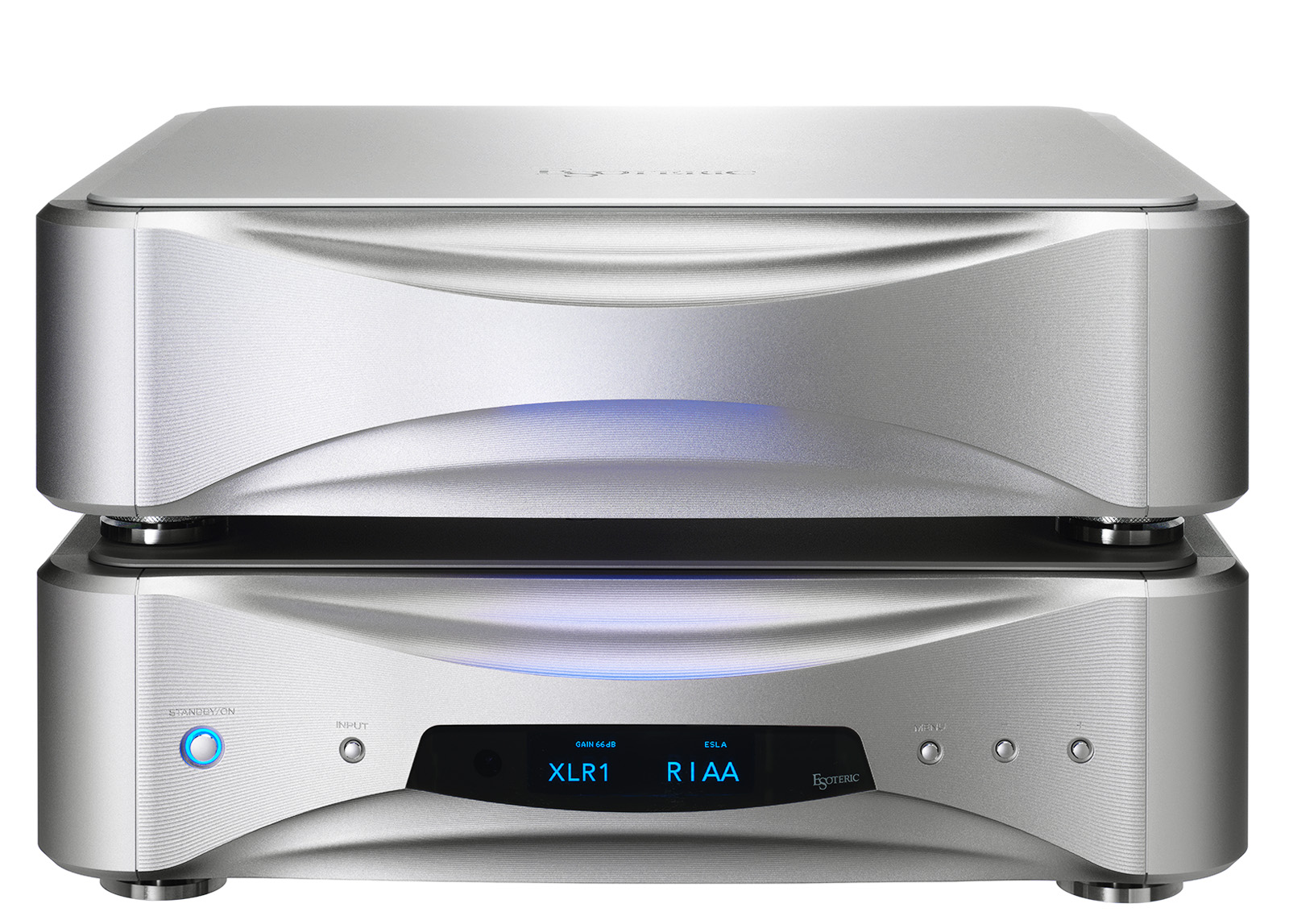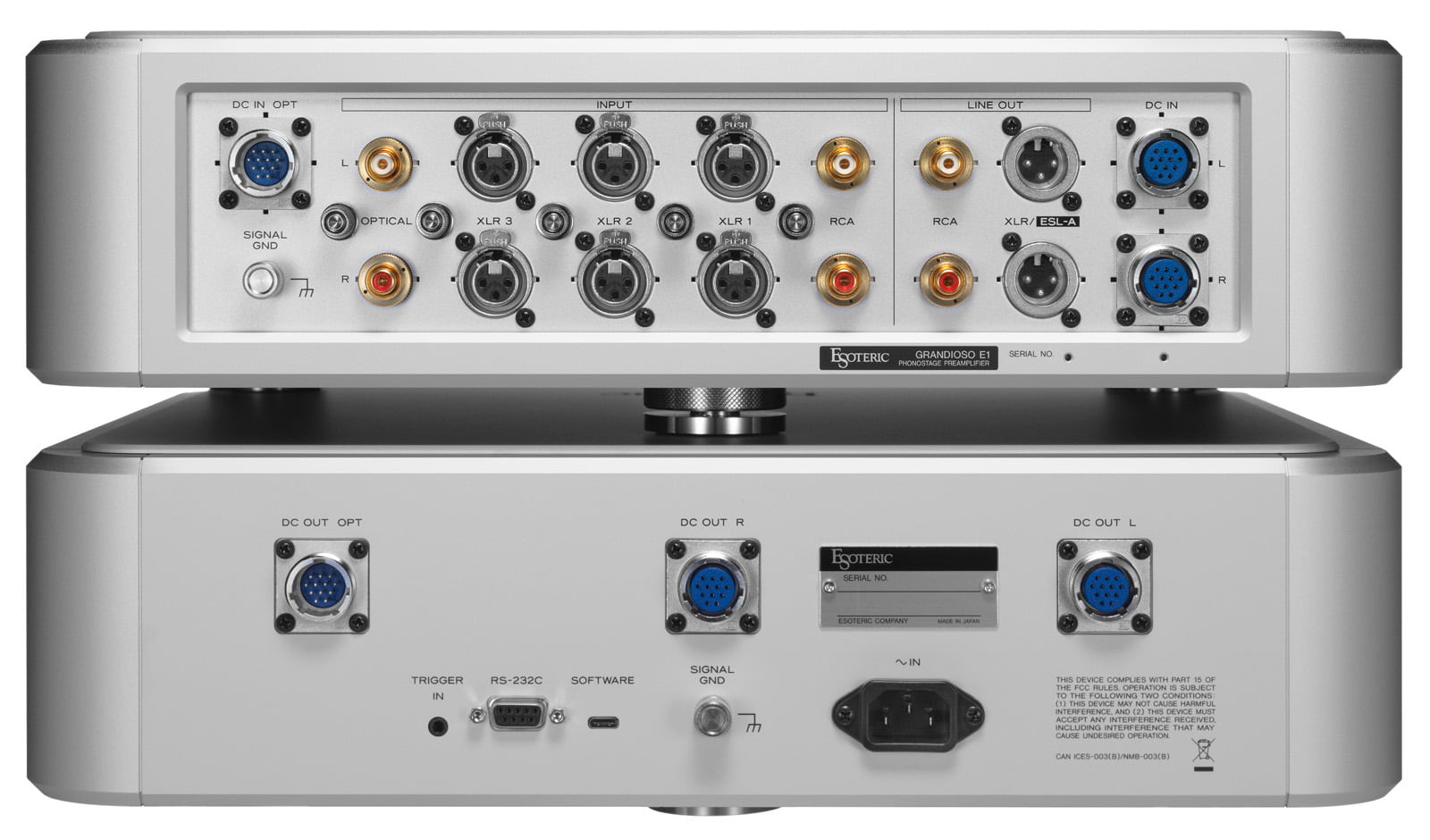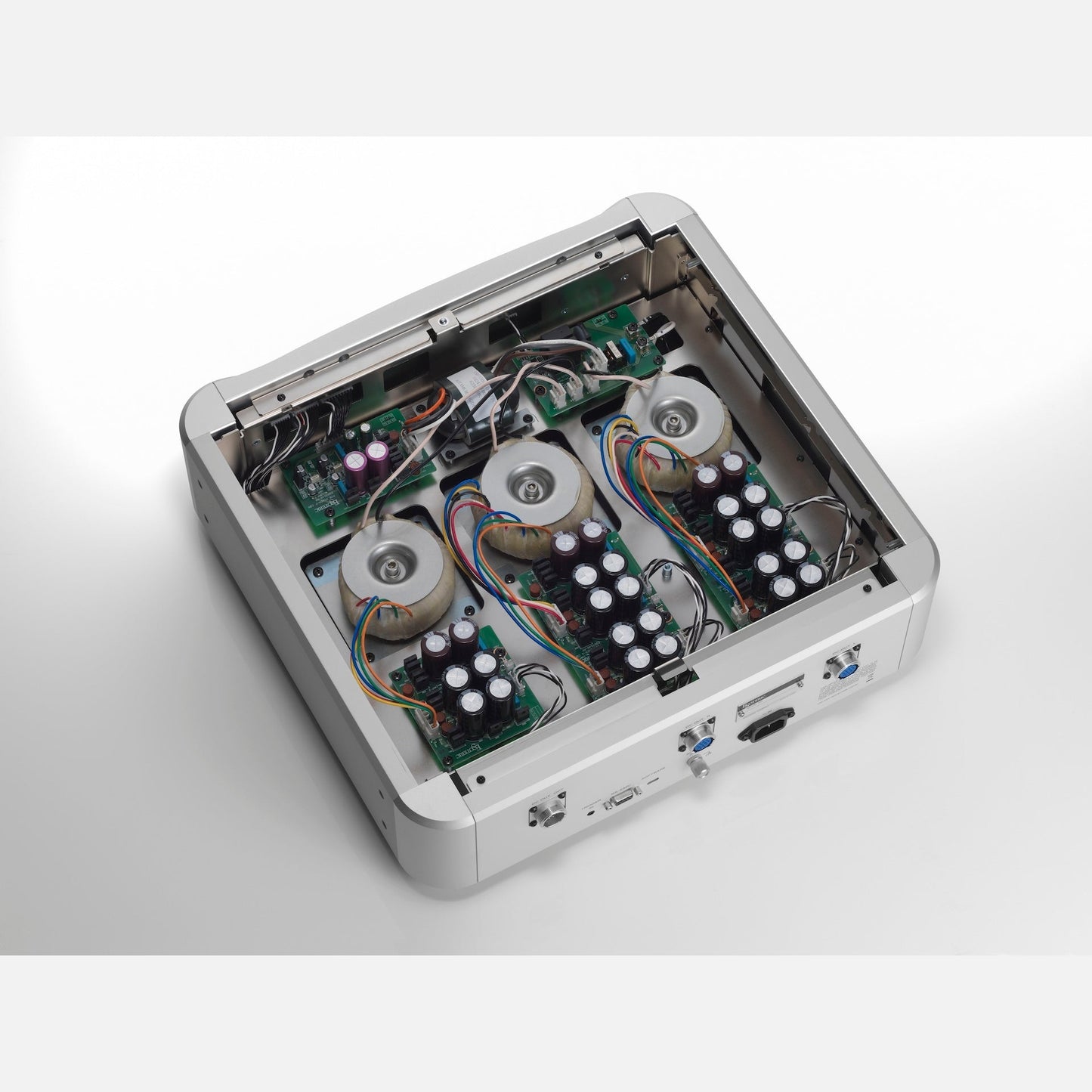Esoteric
Esoteric Grandioso E1 Balanced Phonostage Preamplifier with Separate Power Supply
Esoteric Grandioso E1 Balanced Phonostage Preamplifier with Separate Power Supply
RRP: $50000
A Flagship Phonostage with Innovations That Truly Embody a Renaissance in Vinyl Playback

Reveal True MC Cartridge Sonic Signature
The Grandioso E1 is equipped with three Esoteric original MC balanced current inputs (XLR), which accept the “current” generated by the MC cartridge as a balanced signal. It is not widely known that the output current of MC cartridges is significantly higher than that of MM cartridges. The MC balanced current input is the most efficient and lossless way to extract the full energy generated by the MC cartridge, compared to the conventional “voltage input,” which converts the output current to a “significantly low” micro-voltage via a load resistor. This approach allows the sound inherent in the MC cartridge to be reproduced with all the performance’s reality intact. Additionally, there is no need to worry about impedance matching between the MC cartridge and the phono stage, ensuring that the best sound can always be extracted from the MC cartridge.
MC cartridges use smaller coils than MM cartridges to keep vibrating systems lighter and capable of picking up finer musical details. As a result, the output “voltage” is generally about 1/20th of that of MM cartridges. However, the MC cartridge, with its low-impedance coil and powerful magnet outside the vibrating system, can output a much higher “current” than the MM cartridge. In other words, the MC cartridge is a power generator that excels at delivering power in the form of “current” rather than “voltage.”
In the case of a conventional “voltage input,” the original rich current is converted by the load resistance into a tiny voltage signal of about 1/20th of that of an MM cartridge, resulting in various issues, such as S/N degradation due to the need for large amplification in the following stage, losses due to resistance, and unwanted changes in sonic characteristics due to impedance mismatch. On the other hand, the MC balanced current input allows the high power (high current) of the MC cartridge to be fed directly into the discrete amplifier, enabling the most efficient signal extraction without loss. Additionally, by feeding both ends (+/–) of the MC cartridge’s coil into a balanced amplifier, a signal can be extracted without noise. By using transistors originally designed for current amplification in the gain element, the E1 further enhances design rationality.

Main unit (upper) Power supply/control unit (bottom)
Optical pickup cartridges use an internal LED and a light receiver (PD: photodiode) to optically detect the movement of the cantilever and output it as an analog music signal. The E1 is equipped with a pair of RCA input sockets dedicated to optical cartridges. Since optical cartridges require completely different amplification and equalization methods compared to MM/MC cartridges, the E1 includes an independent, dedicated, fully balanced/dual mono phono stage preamplifier. This unique balanced/dual mono phono stage preamp circuit with an external power supply, discrete low-feedback power regulator, allows you to enjoy the crisp sound of an optical cartridge at the highest possible quality.

Balanced/dual mono phono stage preamp circuit for optical cartridge
The E1 has a pair of RCA input sockets for high-output voltage cartridges, such as MM, MC with an integral transformer, and high-impedance/high-output MC cartridges. The input signal is instantly balanced and amplified by a fully discrete main phono stage preamplifier circuit, which is shared with the balanced current input, ensuring the same uncompromising, superior sound quality as with the balanced current input. The load impedance and capacitance can be adjusted to match the phono cartridge in use.
Spec description
| Inputs | |
| Connectors | |
| XLR | 3 pairs (for MC current input) |
| RCA | 1 pair (for MC/MM voltage input) |
| OPTICAL (RCA) | 1 pair (for optical cartridges) |
| RCA load resistance | |
| MC | 10 Ω, 50 Ω, 100 Ω, 200 Ω, 560 Ω |
| MM | 47 kΩ |
| RCA load capacitance | |
| MM | 100 pF, 220 pF, 320 pF |
| Outputs | |
| Connectors | |
| XLR/ESL-Analog (switchable) | 1 pair |
| RCA | 1 pair |
| Output impedance | |
| XLR | 50 Ω |
| RCA | 18 Ω |
| Audio performance | |
| RIAA deviation | ±0.3 dB |
| Rated output | |
| XLR | 2 V |
| RCA | 1 V |
| Maximum output (1% distortion) | |
| XLR | 6.6 V (XLR, RCA input) / 12 V (OPTICAL input) |
| RCA | 3.3 V (XLR, RCA input) / 6 V (OPTICAL input) |
| Input sensitivity (1kHz)* | |
| MC (current input) | 1.2 mV |
| MC (voltage input) | 0.5 mV |
| MM (voltage input) | 10 mV |
| OPTICAL | 50 mV |
| Gain* | |
| MC (current input) | 65 dB (XLR output) / 59 dB (RCA output) |
| MC (voltage input) | 72 dB (XLR output) / 66 dB (RCA output) |
| MM (voltage input) | 46 dB (XLR output) / 40 dB (RCA output) |
| OPTICAL | 32 dB (XLR output) / 26 dB (RCA output) |
| Current gain adjustment range | –9 to 0 dB (in 3 dB steps) |
| Voltage gain adjustment range | –6 to +4dB (in 2dB steps) |
| Equalizer frequencies | |
| LOW LIMIT (Hz) | 50, 71, 100 |
| TURNOVER (Hz) | 800, 630, 500 (RIAA), 400, 350, 300, 250, FLAT |
| ROLL OFF (10kHz dB) | − 16, − 13.7 (RIAA), − 12.7, − 12, − 10.5, − 8, − 6, FLAT |
| Total harmonic distortion | |
| MM | 0.008% (1kHz, 22k LPF, rated output) |
| OPTICAL | 0.02% (1kHz, 22k LPF, rated output) |
| Subsonic filter | 16 Hz, −6dB/octave |
| General | |
| Power supply | |
| Model for Europe | AC 220-240 V, 50/60 Hz |
| Model for US/Canada | AC 120 V, 60 Hz |
| Power consumption | 48 W |
| Power consumption (In standby) | |
| Remote control input (RS-232C) OFF | 0.3 W |
| Remote control input (RS-232C) ON | 0.7 W |
| External dimensions (W×H×D, including protrusions) | |
| Main unit | 445 × 131 × 445 mm / 17 ⅝” × 5 ¼” × 17 ⅝” |
| Power supply/control unit | 445 × 131 × 451 mm / 17 ⅝” × 5 ¼” × 17 ⅞” |
| Weight | |
| Main unit | 20.7 kg /45 ¾ lb |
| Power supply/control unit | 23.4 kg / 51 ⅝ lb |
| Included accessories | AC power cord × 1 DC power cord (male)× 2 DC power cord (female)× 1 Remote control (RC-1343)× 1 Batteries for remote control × 2 Owner’s manual × 1 Warranty card × 1 |
* [MC current input] measured with 0dB C.gain, 0dB Gain, and cartridge with 40Ω impedance
[MM/MC voltage input] measured with 0dB Gain setting
[OPTICAL] measured with HI Gain setting
*Design and specification subject to change without notice.
Share










